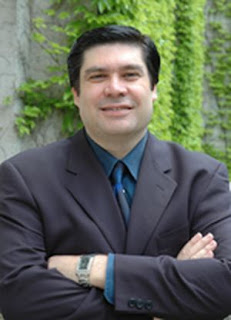Researchers from Northwestern University have now demonstrated the ability of a third-generation nanofountain probe (NFP) to directly deposit gold nanoparticles, 15 nanometers in diameter, onto silicon substrates. The research is published online by the scientific journal Langmuir.
“Such a direct-write method of deposition provides better control over resultant patterns and simplifies the process of fabricating functional structures, as compared to conventional photolithographic or microstamping techniques,” said Horacio D. Espinosa, professor of mechanical engineering in the Robert R. McCormick School of Engineering and Applied Science and co-author of the paper. Espinosa’s group pioneered the development of the nanofountain probe.
The NFP is a cantilevered probe chip that can be mounted on commercial atomic force microscopy (AFM) equipment. On-chip reservoirs hold liquid inks such as nanoparticle solutions, which are delivered through enclosed channels to ring-shaped apertured tips. High throughput microfluidic transport of molecular inks to AFM tips is of great interest since fluid is a very effective medium for the direct delivery of molecules, which self-assemble on substrates with very specific nanoscale architectures.
“The ultimate goal of this project is to develop a robust microsystem platform for the mass production of nanoscale devices, sensors and structures using chemicals, biomolecules, nanoparticles, nanotubes and nanowires,” said Espinosa.
Previous versions of the nanofountain probes were shown to be capable of depositing solutions of fluorescent dyes, alkanethiols and DNA. Among several design changes, the latest nanofountain probes have deeper microchannels to allow the facile delivery of larger particles such as gold nanoparticles 15 nanometers in diameter.
Probe-based deposition techniques are amenable to high-resolution, nanoscale and flexible patterns in which the desired structure can be easily altered at any time. Dip-pen nanolithography (DPN), in which a commercial AFM probe is coated with molecules to be deposited, is capable of making high-resolution patterns of many chemicals and biological materials. However, standard DPN techniques have not been able to deposit suspensions of solid nanoparticles.
“The nanofountain probe is not only capable of delivering such solutions but can do so continuously because the inks are contained in reservoirs on the chip,” said Andrea Ho, a co-author and graduate student in Espinosa’s group.
Because NFPs are batch-fabricated using standard micromachining processes, they can easily be mass-produced. The current NFPs produce nanoscale patterns with a linear array of 12 writing tips, but their design allows for straightforward scaling up to 2D arrays of tips. This would allow for the high-throughput, parallel deposition of nanoparticles with high resolution.
In addition to Espinosa and Ho, the Langmuir paper was authored by former post-doctoral fellow Bin Wu (lead author) and former research associate Nicolaie Moldovan.
The research was supported by the Nanoscale Science and Engineering Initiative of the National Science Foundation.
Contact: Megan Fellman fellman@northwestern.edu 847-491-3115 Northwestern University
Technorati Tags: Nano or Nanotechnology and Nanotech and gold nanoparticles or nanofountain probe and Northwestern University or Resignation of Atty. Gen. Alberto Gonzales VIDEO and The Taj Mahal and Physicist Opens New Window on Glass Puzzle















No comments:
Post a Comment